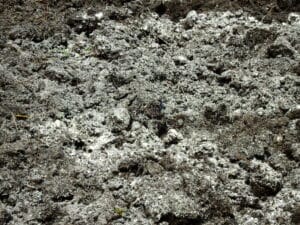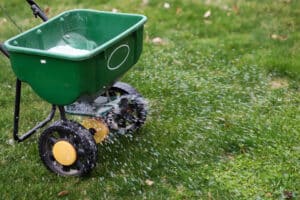The summer heat can damage your lawn, especially if you don’t take the proper precautions and make a lawn care plan. Maintaining a summer lawn requires a consistent routine, including fertilizer application, mowing, watering, and treatments for pests and weeds.
This guide provides summer lawn care tips to help you maintain and enjoy a beautiful lawn. If you prefer not to DIY your lawn care, the best professional lawn care companies can keep your lawn healthy and lush during the summer.
Get a Quote From Lawn Professionals Near You
Compare quotes from local pros

Lime Soil Amendment

Lawn Fertilization
In Early Summer
As early summer sets in, your lawn is entering a period of rapid growth and increased stress from heat and pests. To keep it lush and healthy, focus on mowing at a higher setting to encourage deep roots, treating for common pests before they become a problem, and keeping up with regular weeding. These simple steps will help your grass stay strong through the warmer months.
Fertilize Warm-Season Grass
Fertilizing in the early summer can boost the growth of your warm-season grass, which grows best at about 70 degrees Fahrenheit, to make it thick and healthy. At the right time, fertilizing can also make your grass more heat- and drought-resistant.
However, if you apply too much, you risk burning your lawn. Grass already gets stressed during these months, so exercise caution when applying fertilizer. Use a fertilizer formulated specially for summer feedings and follow the instructions exactly.
- If you have cool-season grass, do not fertilize in the summer. The best time to fertilize cool-season grass is in the spring and the fall.
Mow High
Mow the grass high to encourage strong root growth and heat tolerance. Taller grass provides more shade, keeping weeds from germinating and competing with your grass. Start by sharpening your mower blades. Dull blades will tear and shred your grass instead of giving it a clean cut, making the grass more susceptible to losing moisture. Mower blades typically stay sharp through 10 hours of mowing.
Set your blades higher in the summer months, and cut the heights according to grass type. Warm-season grasses should be cut to 2–3 inches tall, while cool-season grasses should be mowed at 3–4 inches. As a general rule, try not to cut more than 1/3 of the grass blade each time you mow.
Leave the clippings on the lawn, or grasscycle, when you mow. They will decompose and help feed your grass.
Treat for Pests
Insects may come out in full force in the summer—just remember that not all of them will hurt your lawn. But you’ll want to act if you see bugs like Japanese beetles, June bugs, and European chafers that will munch on your grass, causing wilting and bare patches. If left untreated, Japanese beetles will feed on your grass and lay eggs, which will hatch into grubs and start feasting on your grass.
Head this off at the pass by applying a preventative grub control product.
Control Weeds
If you act fast in the summer, you can kill established weeds before they can bloom and spread seeds. Use a targeted post-emergent herbicide designed to eliminate broadleaf weeds but leave your grass unharmed. Be mindful that even these herbicides may hurt your grass, so use them sparingly. If you’re able to hand-pull the weeds, consider going that route instead.
In Mid-Summer
By mid-summer, rising temperatures and dry spells can take a toll on your lawn. To keep it thriving, water deeply but less often, and feed your grass as needed to maintain its color and resilience. With the right care, your lawn can stay green and healthy even in the summer heat.
Water Deeply and Infrequently
Dry, hot weather can deplete your soil moisture. Moisture stress can lead to wilted grass blades, reduced shoot and root growth, and greater susceptibility to pests and weeds.
To combat this, you should water thoroughly about once or twice a week, so long as your region isn’t experiencing any drought conditions that call for water restrictions. The water should reach 4–6 inches deep. If you’re unsure, push a screwdriver into your soil. If you meet a lot of resistance, you need to water more. If it slides in too easily, you need to water less.
Quick Tip
- It’s best to water your lawn in the early morning before sunrise. That’ll keep the sun from drying out the moisture before your lawn can soak it up. Pay attention to weather forecasts—you don’t want to water too much on weeks when it will rain.
Feed Grass As Needed
Your lawn may need a mid-summer feeding to promote healthy growth. This is especially true of warm-season grasses like you’ll find in the South. But you don’t want to burn your already heat-stressed grass. Check with your local garden store to see if they have any recommendations on whether you should fertilize, and if so, which type to use.
In Late Summer
In late summer, continue the top-notch watering and mowing practices you’ve put into place. That should do the trick, but if you want to get a jumpstart on fall lawn care, consider aeration and overseeding.
Aerate Your Lawn
This isn’t a requirement, but if you want, you can use a core aerator to break up compacted soil. You can rent a core aerator, which pulls up plugs or “cores” of soil from the ground, creating air vents that let your grassroots access air, nutrients, and water. Aerating gives your lawn extra hardiness, helping it to withstand stressors.
Overseed Your Grass If Needed
If your lawn struggles from bare patches or thinning grass, you can restore it to its former glory with overseeding. Sowing additional seed over existing grass and overseeding will thicken your turf.
Professional Lawn Care
If you’re worried about keeping track of what to do for your lawn during the summer months, hiring a professional lawn care company like TruGreen might be your answer. TruGreen offers five different annual plans, promising to return every four to six weeks on an easy, established schedule.
TruGreen doesn’t offer mowing or irrigation services, but the lawn care company offers multiple plans that cover fertilization, weed control, pest control, aeration, and overseeding, depending on where you live.
You can see a breakdown of the three core plans below:
TruGreen Plans and Coverage
Plans | TruHealth℠ Lawn Care Plan | TruComplete℠ Lawn Care Plan | TruSignature℠ Lawn Care Plan |
|---|---|---|---|
|
Fertilization |
✓ |
✓ |
✓ |
|
Lime soil amendment |
✓ |
✓ |
✓ |
|
Pre-emergent and targeted weed control |
✓ |
✓ |
✓ |
|
Aeration |
✓ |
✓ |
|
|
Overseeding* |
✓ |
✓ |
|
|
Tree and shrub services |
✓ |
*The TruComplete Lawn Care Plan and TruSignature Lawn Plan only offer overseeding for fescue lawns.
For full-program customers, plans are backed by TruGreen’s Healthy Lawn Guarantee®—if you have persistent problems between scheduled visits, a highly trained TruGreen lawn care specialist will return to your lawn as many times as needed to make sure treatments are effective.
Our Conclusion
Your lawn may need some extra attention during the summer to prevent wilting, browning, and bare patches caused by higher temperatures. By following these summer lawn care tips, you’ll enjoy a healthier, greener lawn during the hotter months. You can DIY lawn care, but if you don’t have the time, consider hiring a professional lawn care company.
FAQs About Summer Lawn Care
What should I put on my lawn in the summer?
You should put fertilizer on your lawn in the summer. Ensure you only apply fertilizer to warm-season grass. The best time to fertilize cool-season grass is in the spring and fall.
How do I keep my grass nice in the summer?
We recommend watering deeply and infrequently, once or twice a week, to keep your grass nice in the summer. This schedule leads to stronger root development and drought resistance.
What is the best fertilizer for grass in the hot weather?
The best fertilizer for grass in the hot weather is a low-nitrogen fertilizer. Fertilizers rich in nitrogen are best for the early spring green-up. Adding extra nitrogen during the summer can cause stress to lawns and burns.

